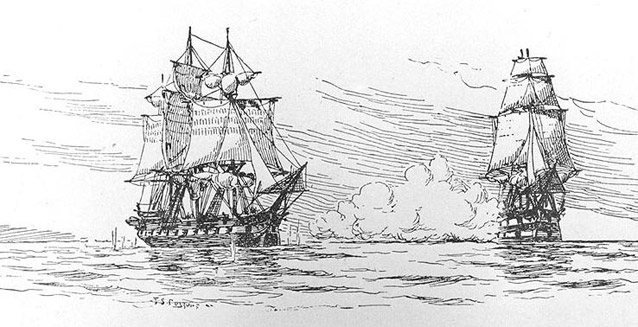The Royal Navy’s humiliating attack on the USS Chesapeake left many Americans clamoring for war, but there was little the ill-prepared United States could do to answer British aggression.
“Never since the Battle of Lexington have I seen this country in such a state of exasperation as at present, and even that did not produce such unanimity.” President Thomas Jefferson

U.S. Navy
As his Royal Navy vessel patrolled off the coast of Virginia, Londoner and former tailor Jenkin Ratford and four other crewmen decided to steal a boat and desert to the shores of Norfolk. Ratford later boasted of his escape to the “land of liberty” in Norfolk’s streets, where his contempt incurred the ire of British authorities. They vowed to make an example of the brazen Englishman, who joined the crew of an American frigate, the USS Chesapeake.
In June 1807, the Chesapeake set sail from Norfolk for the Mediterranean. Its decks scattered with cargo and its guns unwisely stowed, the vessel made an appealing target for the crew of a British vessel, the HMS Leopard, who intercepted it off the coast of Norfolk and aimed to take revenge.
When the British commander requested permission to search the ship for deserters, the American commodore James Barron refused to muster his crew for inspection. Moments later, the captain of the Leopard responded with a barrage of broadsides, killing three Americans and wounding eighteen. British officers then proceeded to board the crippled Chesapeake and seized what they had come for: a handful of suspected deserters, including Jenkin Ratford.
The humiliating exchange infuriated the American public. War fever raged up and down the coast of the United States. President Thomas Jefferson maintained that the country was more exasperated than at any time since the 1775 battle at Lexington Green that touched off the War of Independence, “and even that did not produce such unanimity.” With Republicans and Federalists—normally bitterly divided political factions—both clamoring for action, war between Britain and the U.S. seemed imminent.
In reality, however, there was little President Jefferson could do militarily to respond to the British transgression. America’s small navy was already deployed in the Mediterranean checking the Barbary pirates. America’s army had been long since been gutted by Republicans anxious to reduce government spending. As Jefferson bided his time and war fever subsided, he instead pursued economic coercion as an alternative to war. That economic pressure began a few months later with the passage of the Embargo Act.
The exchange between the Chesapeake and the Leopard had other consequences for its participants, however. Commodore Barron was later court martialed; found guilty of “neglecting on the probability of an engagement, to clear his ship for action,” he was suspended from the navy for five years without pay.
And on August 31, 1807, the Royal Navy got its revenge on the tailor who had deserted his vessel. Tried by court-martial for mutiny, desertion and contempt toward a British naval officer, and sentenced to death, Jenkin Ratford met his end—hanged from the fore yardarm of his former vessel, the HMS Halifax.
Last updated: May 24, 2016
